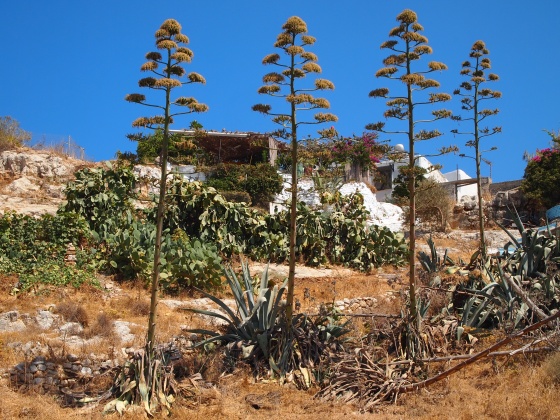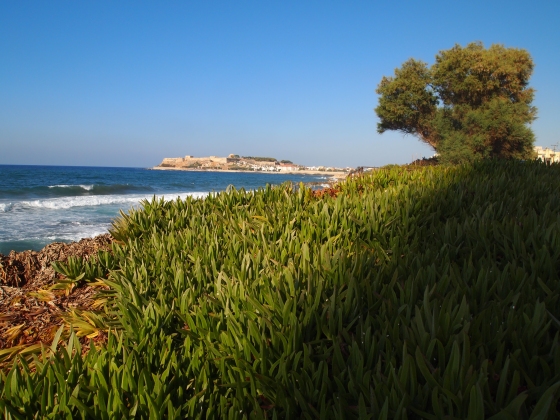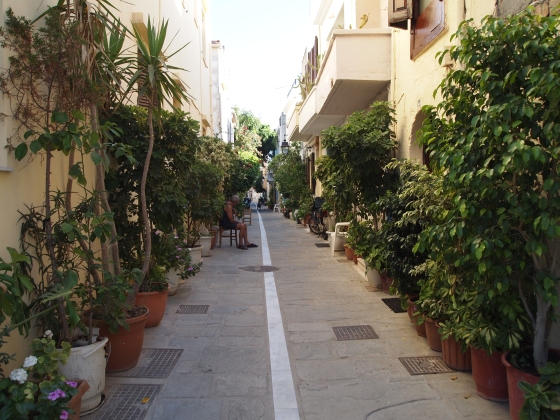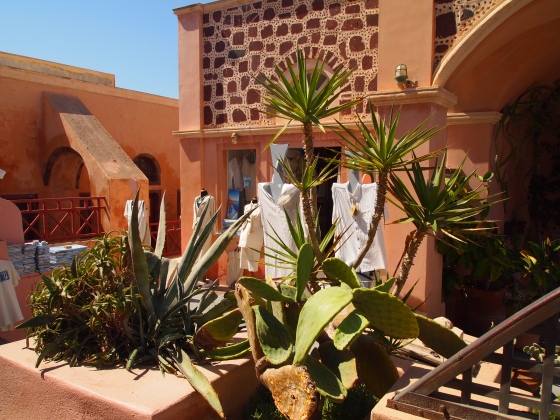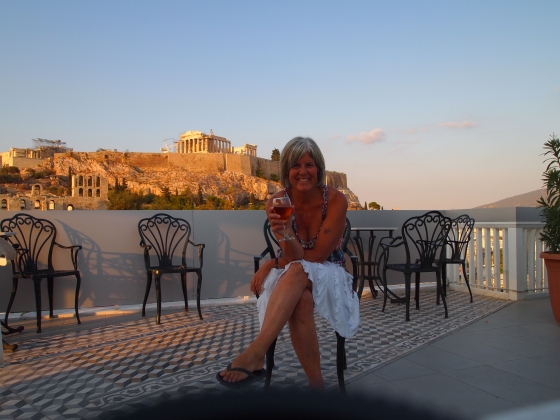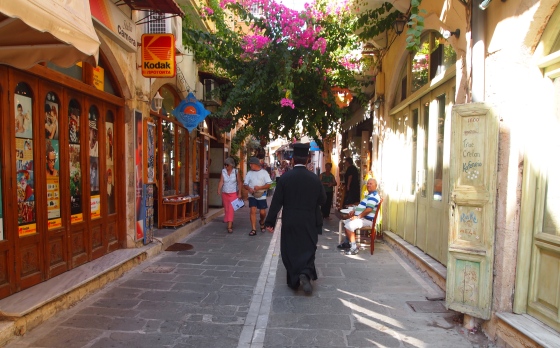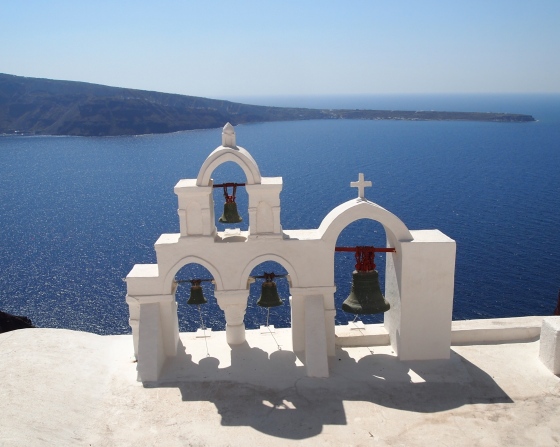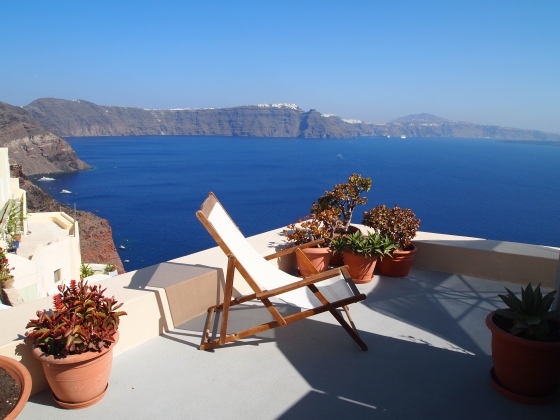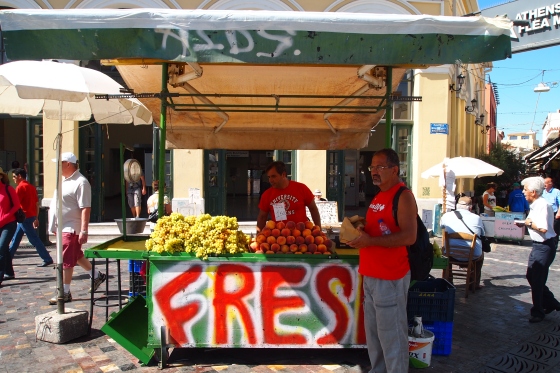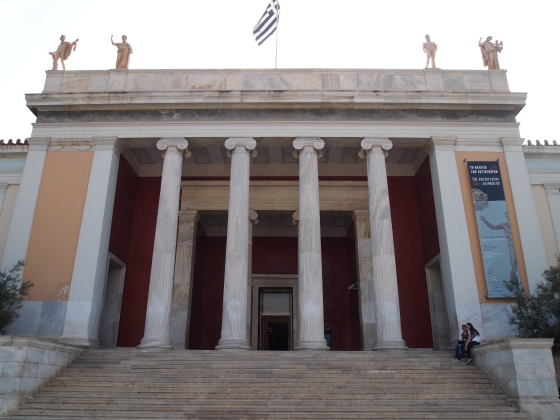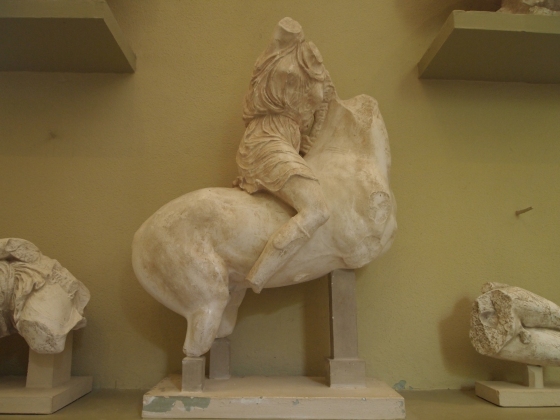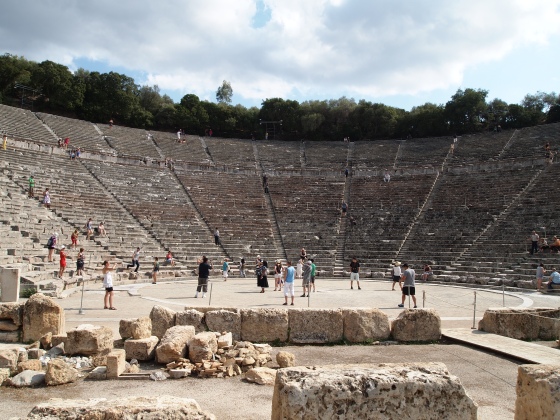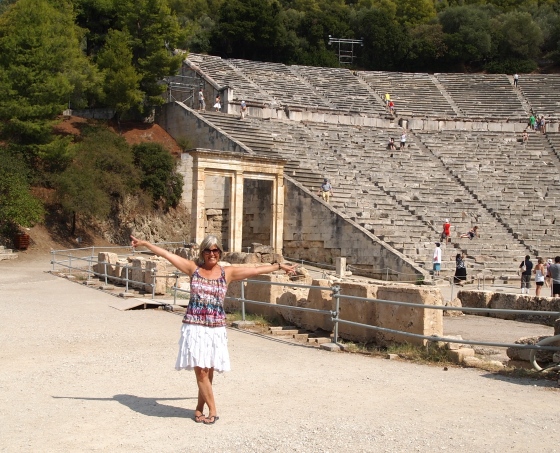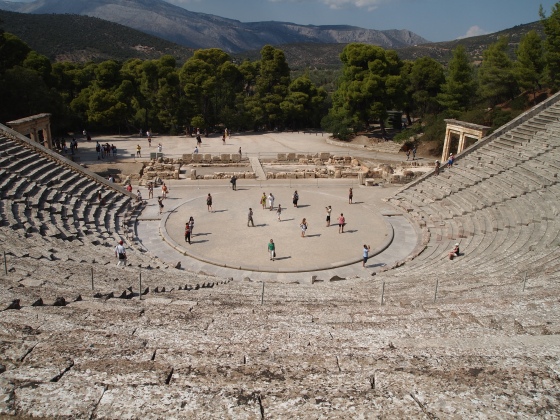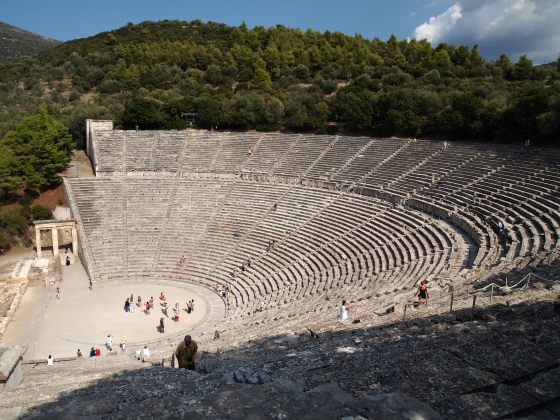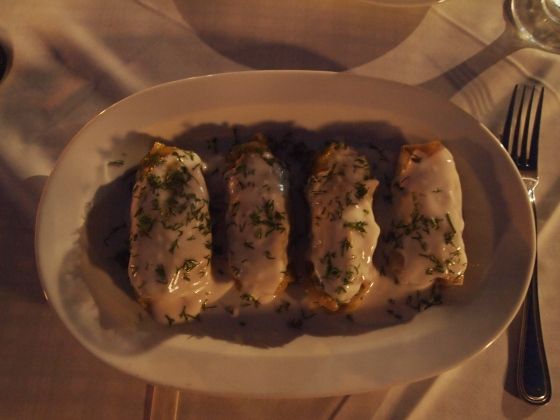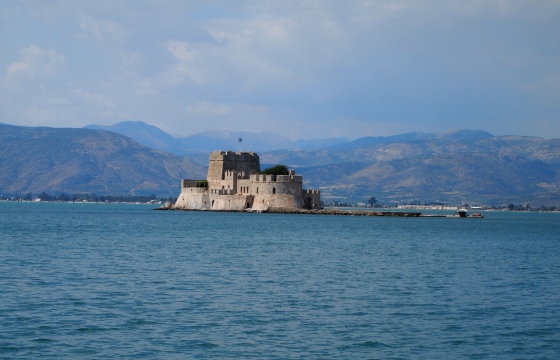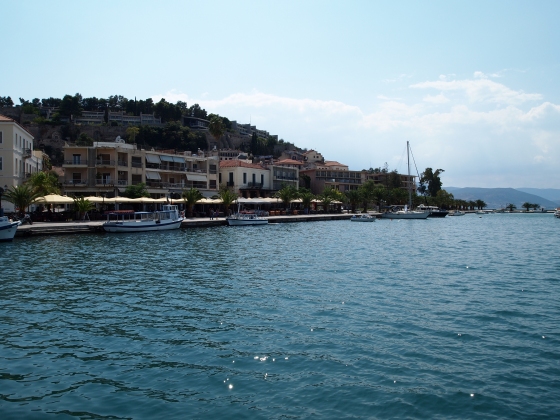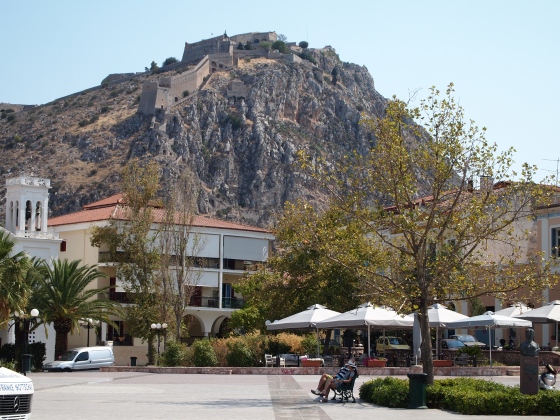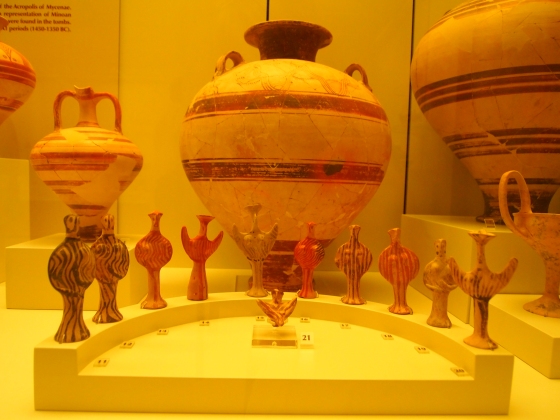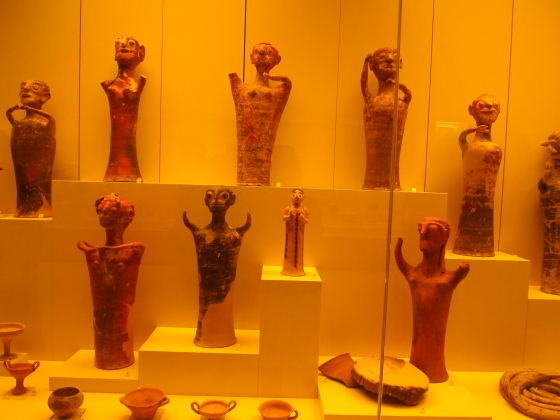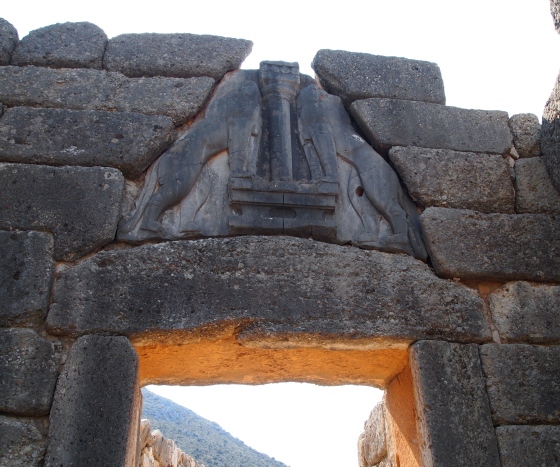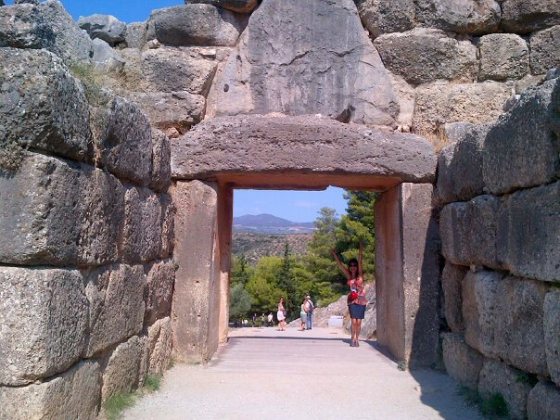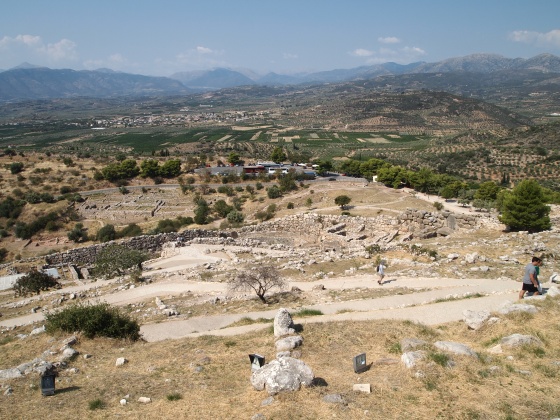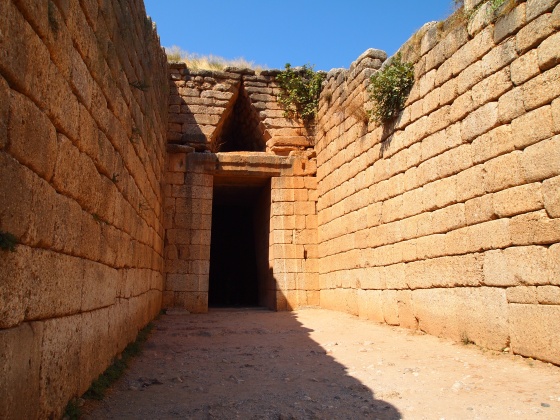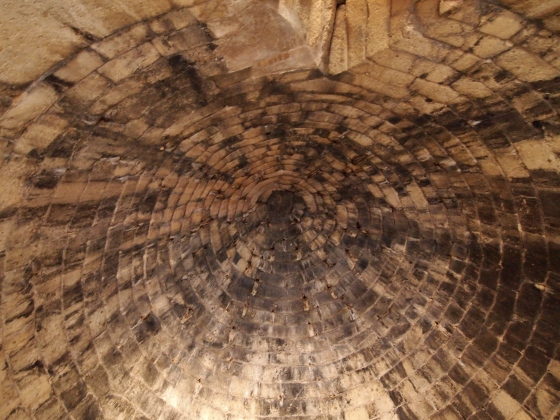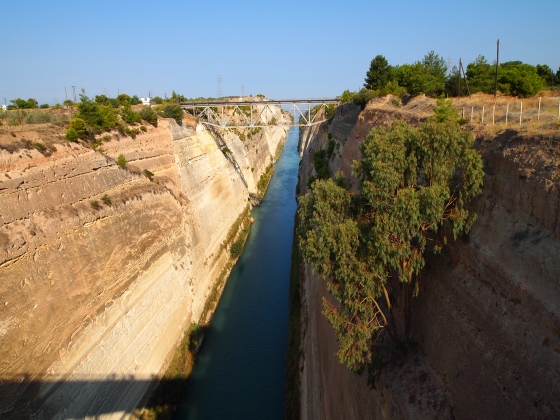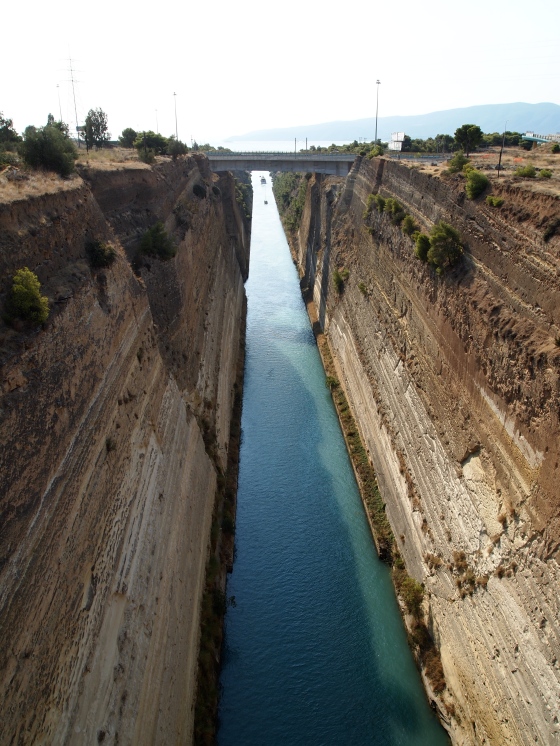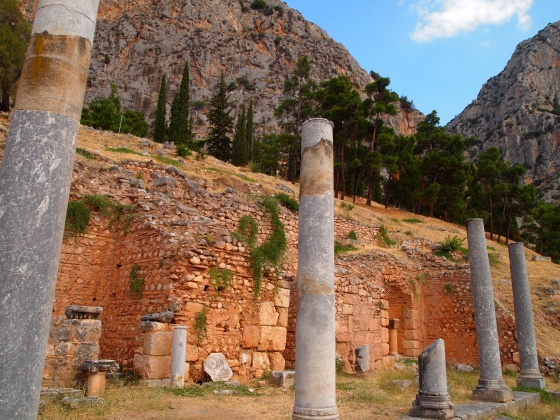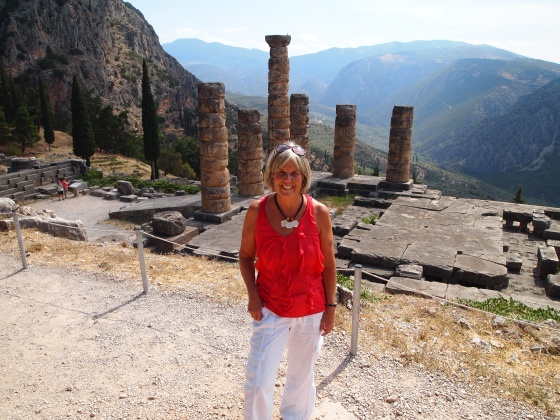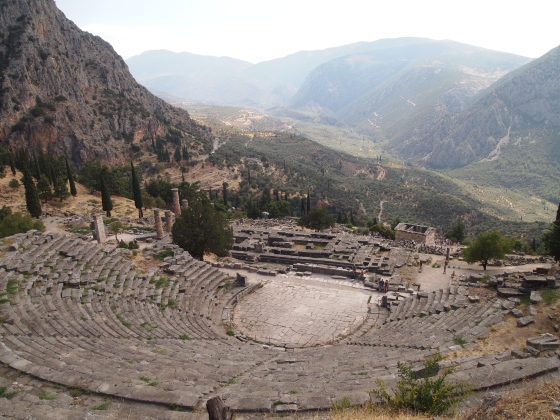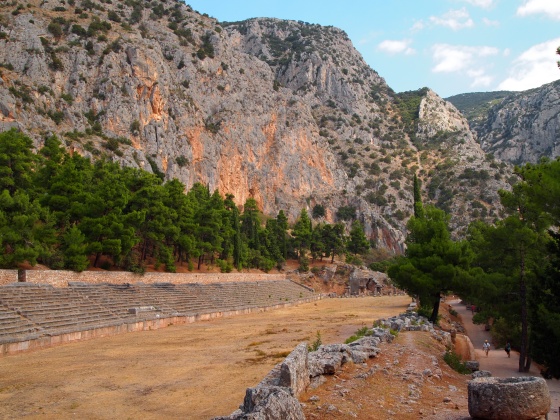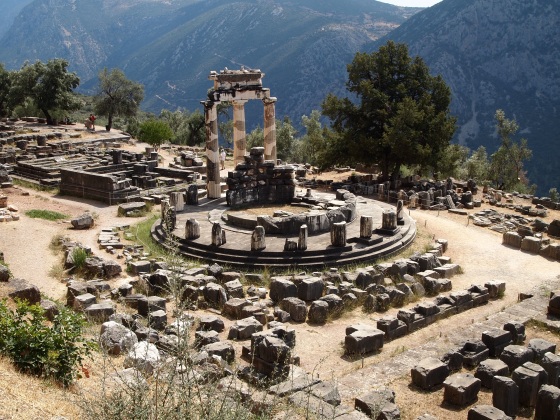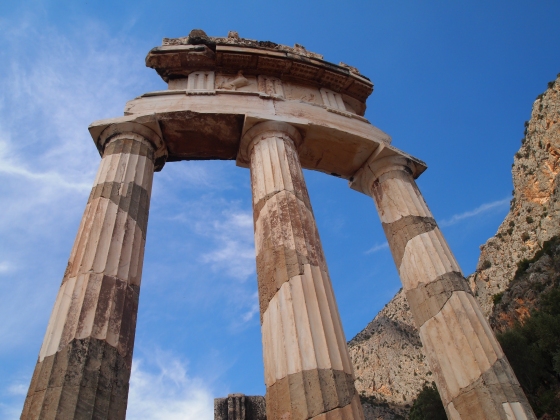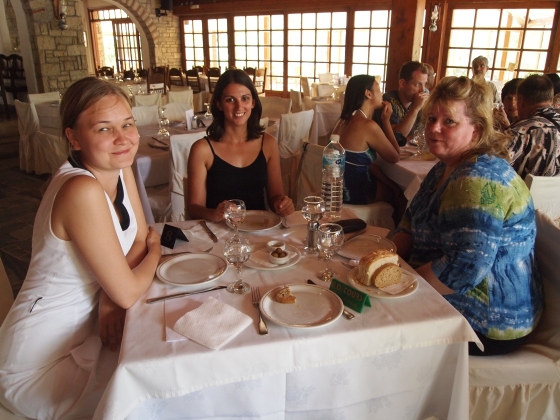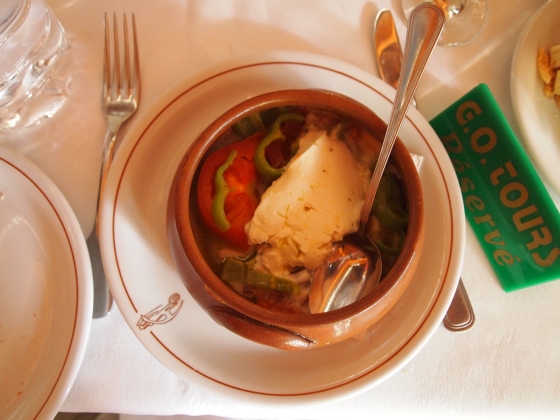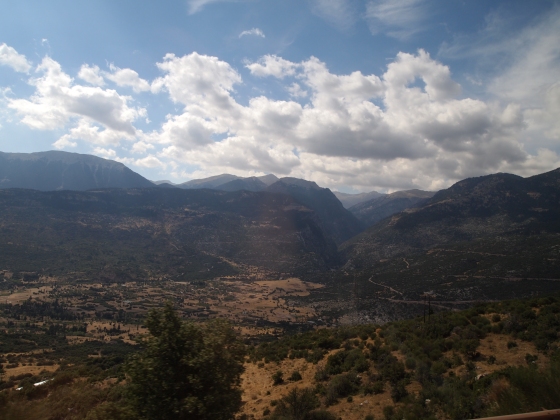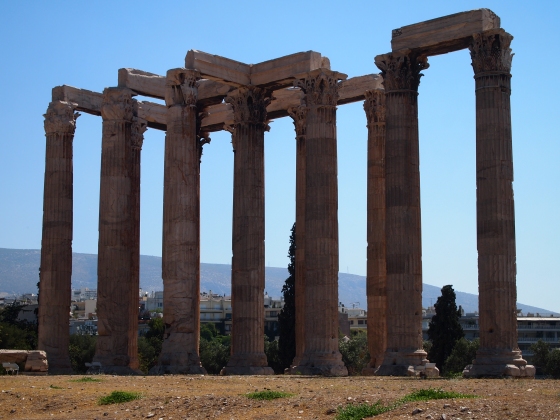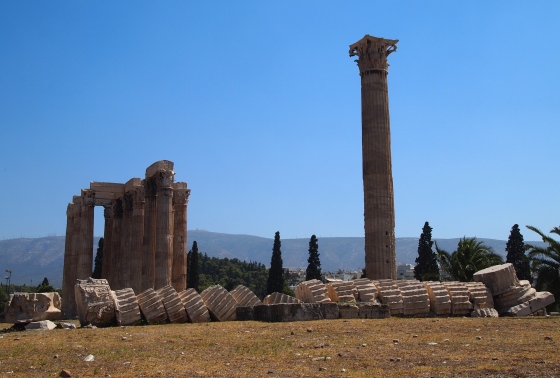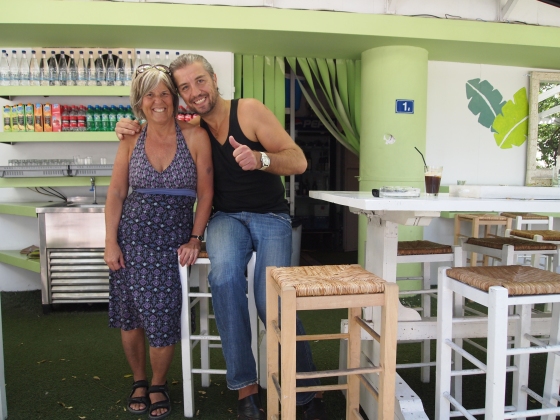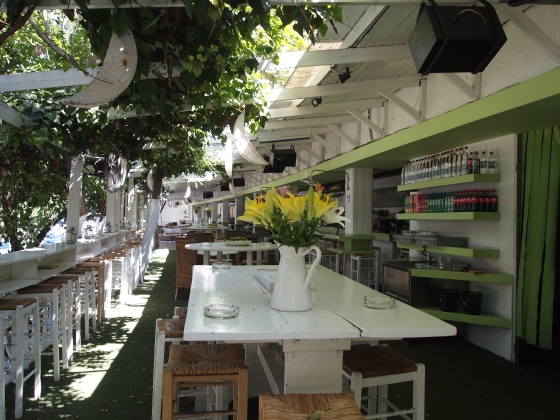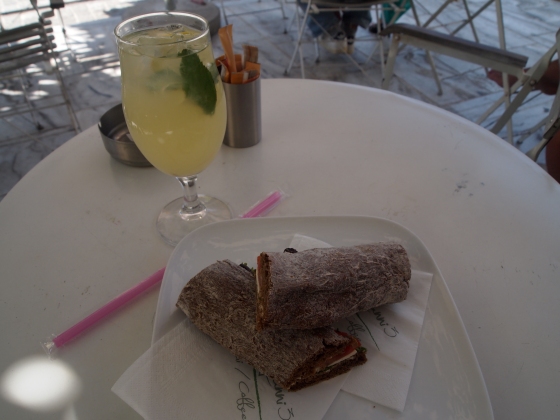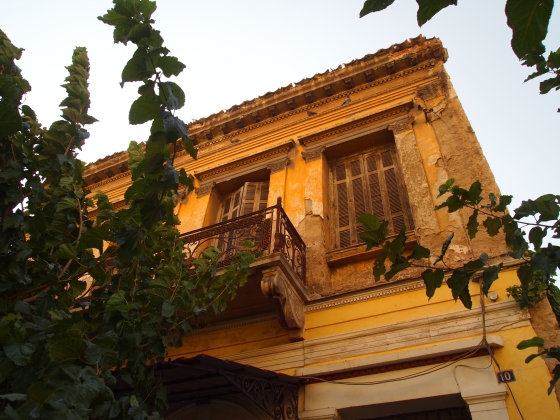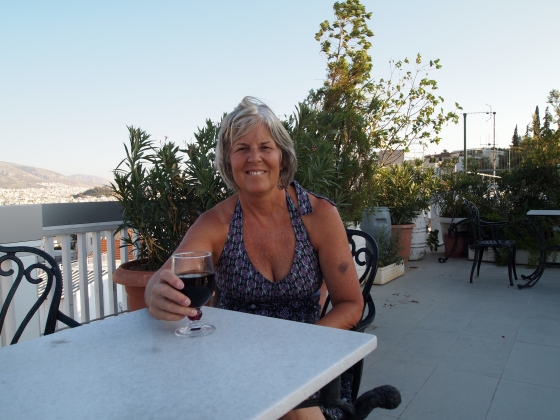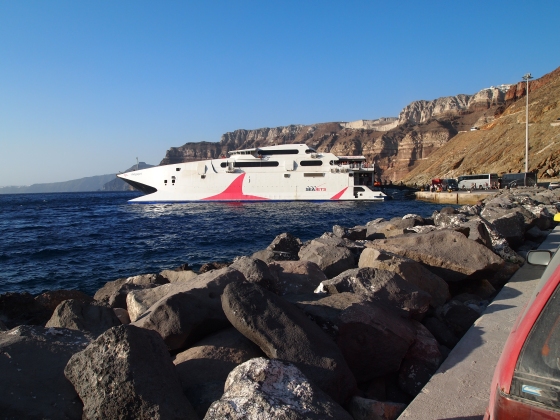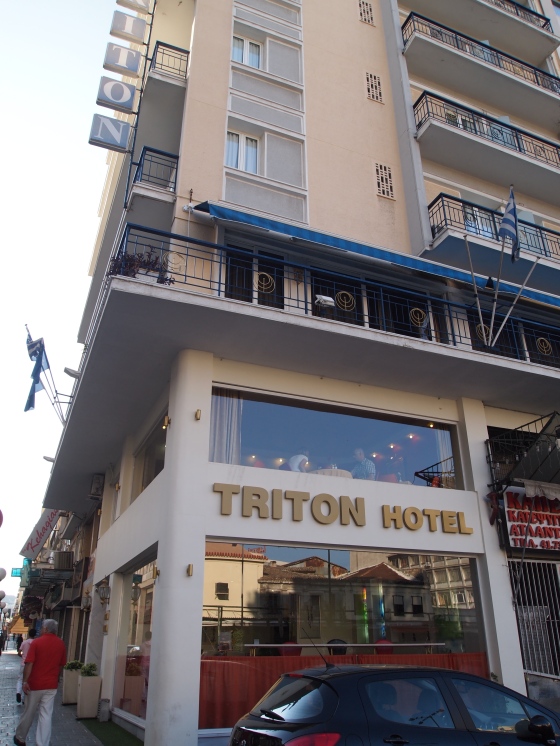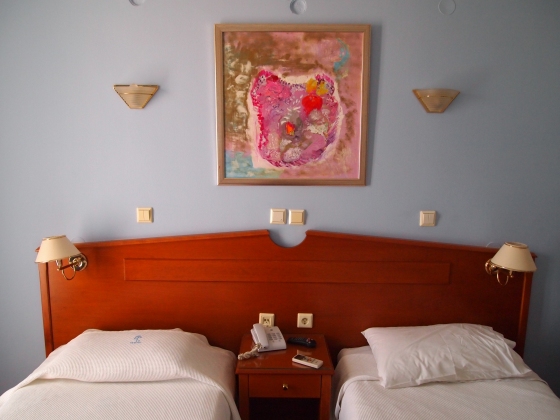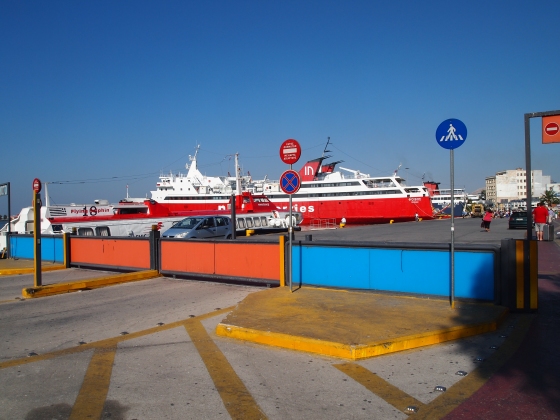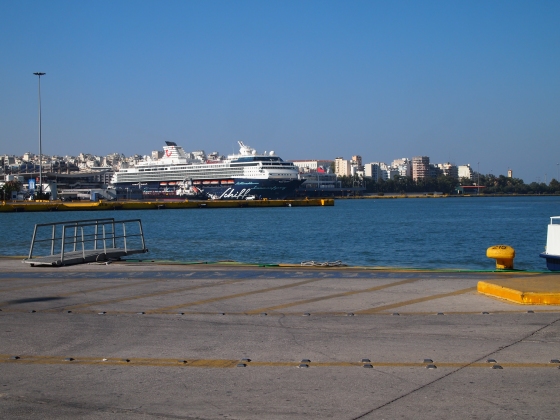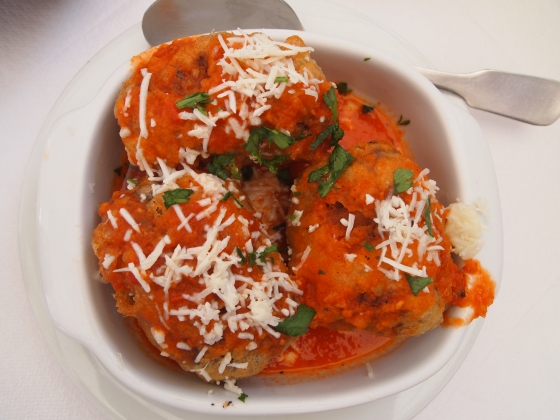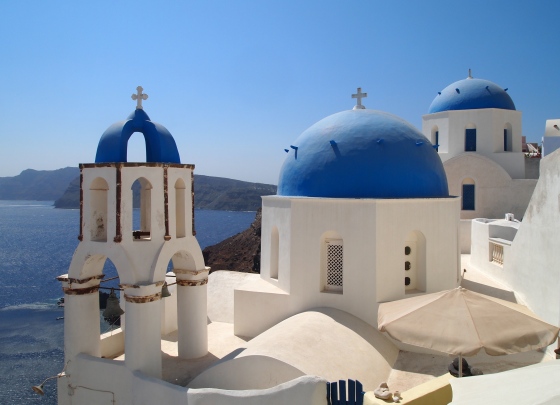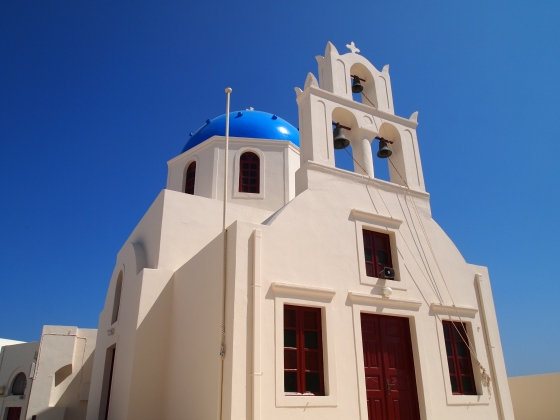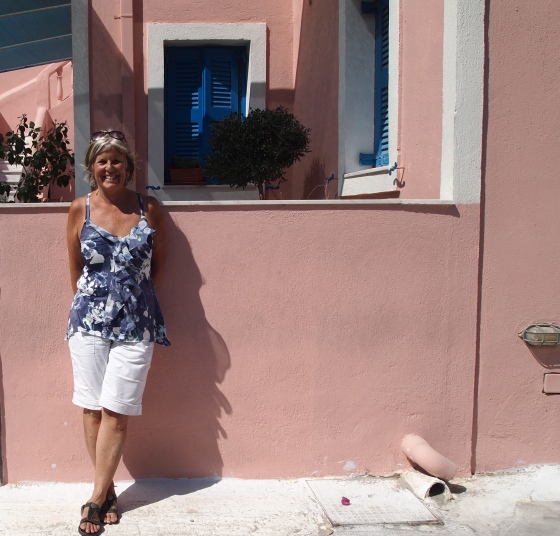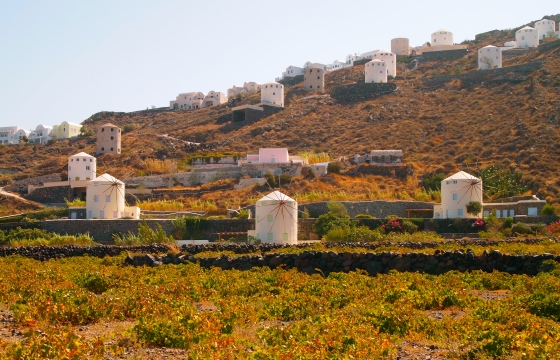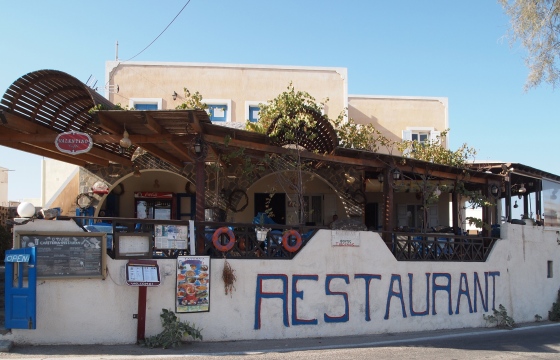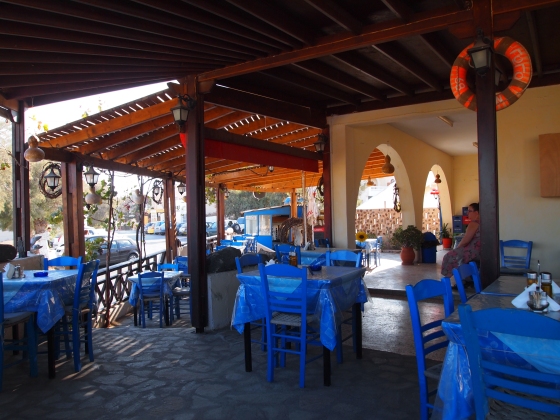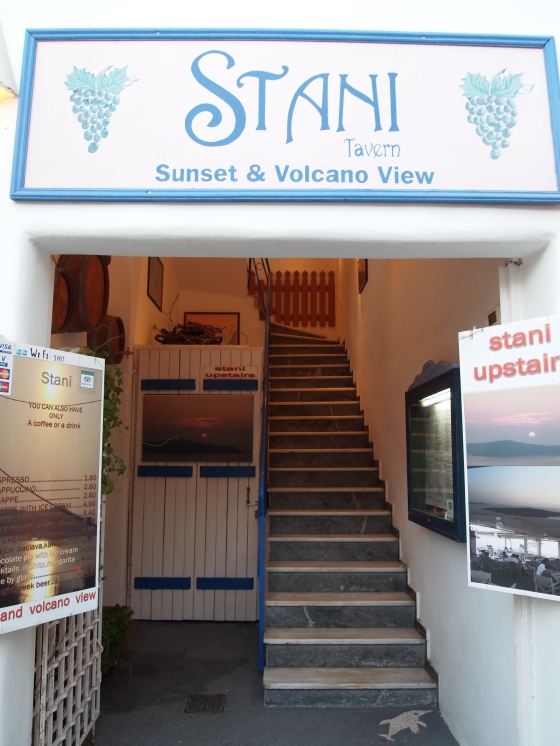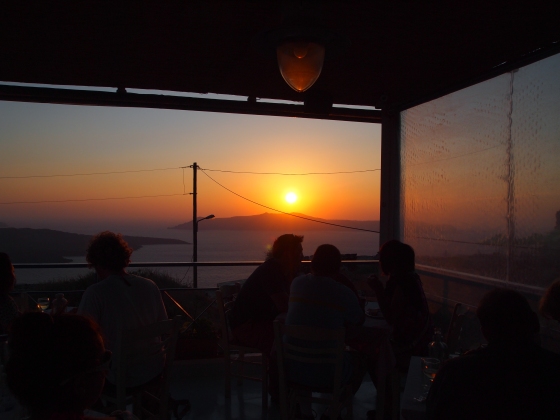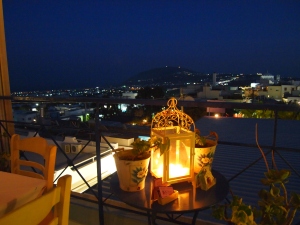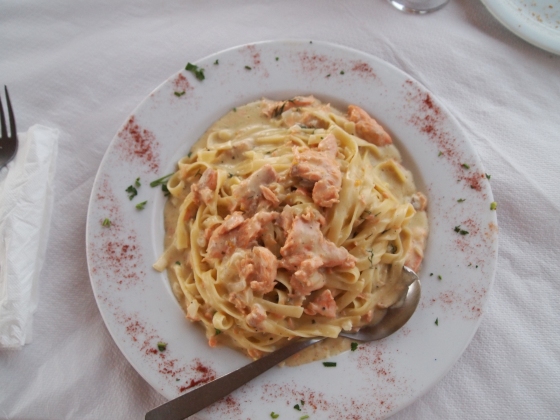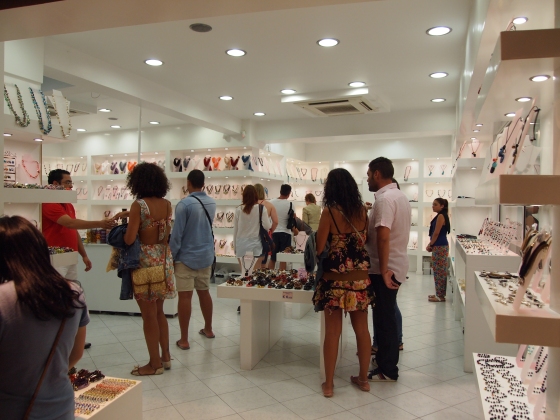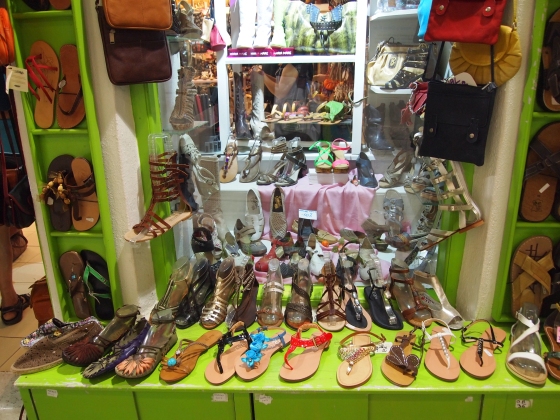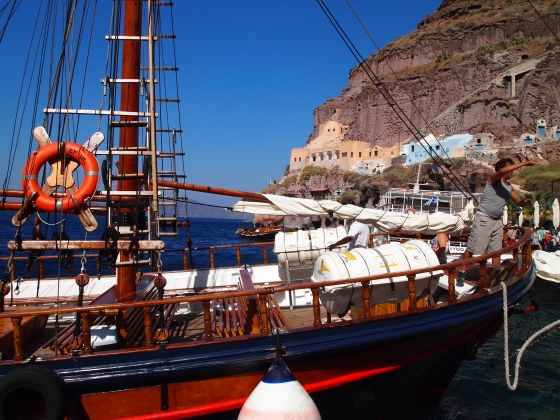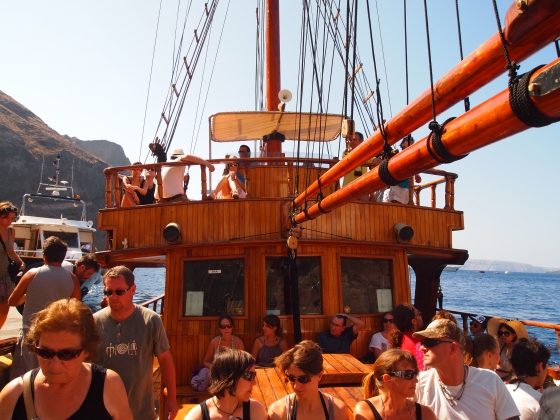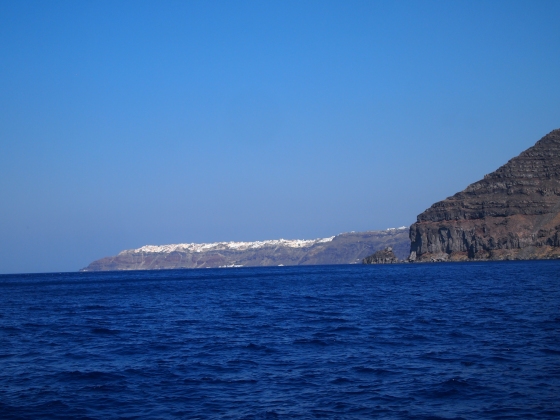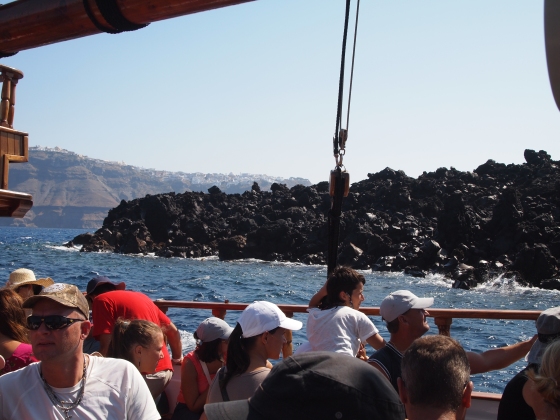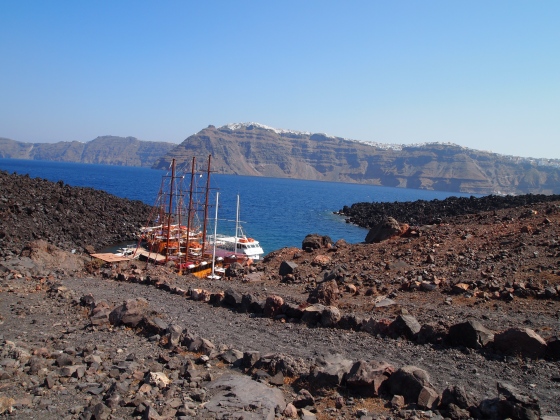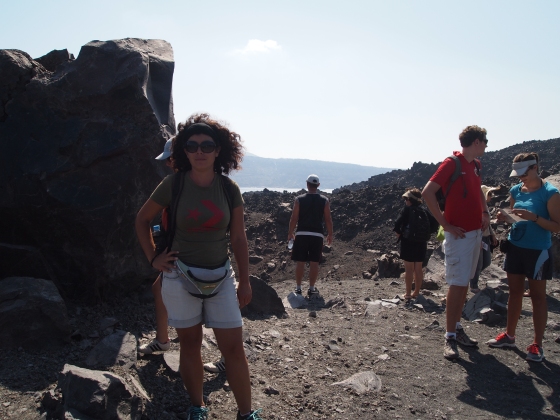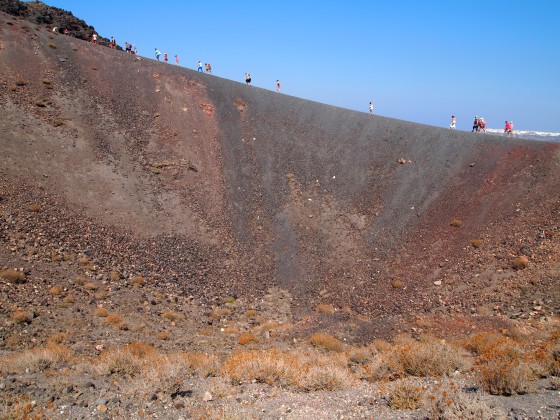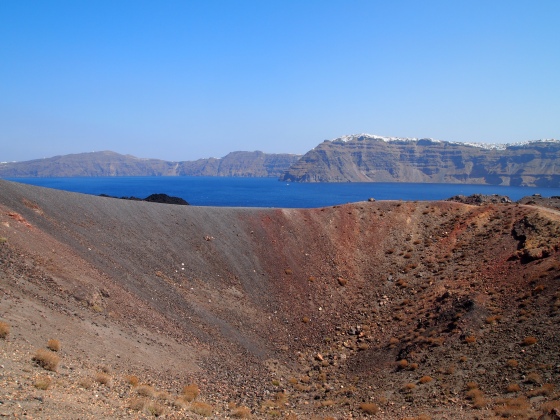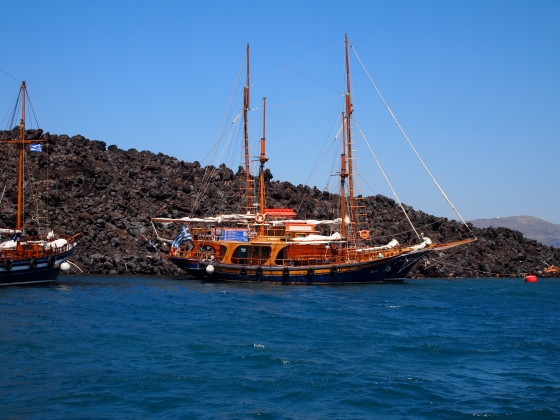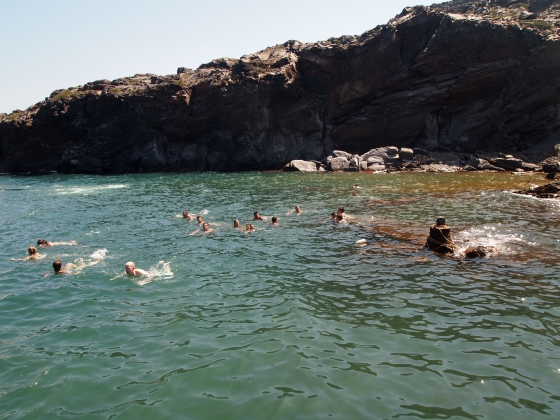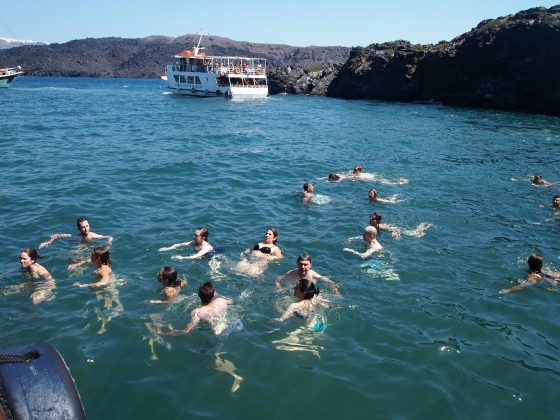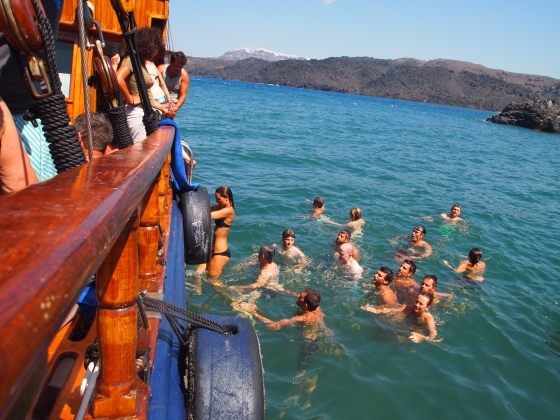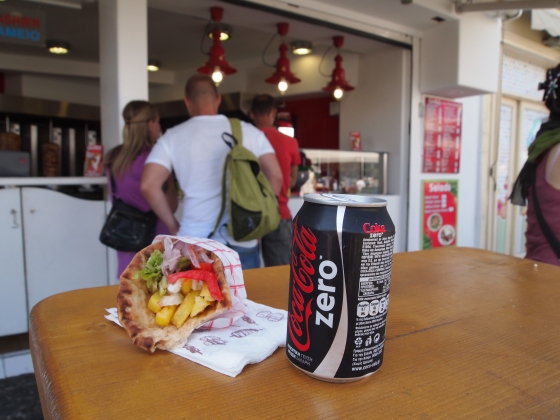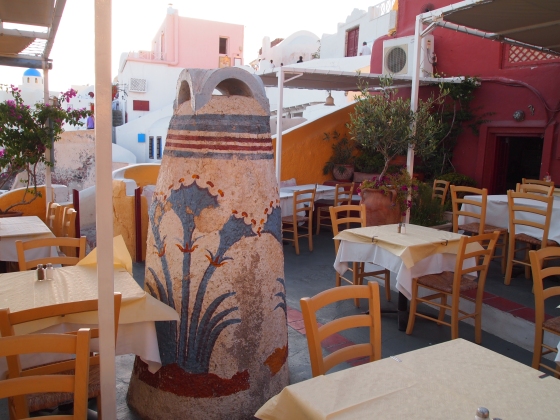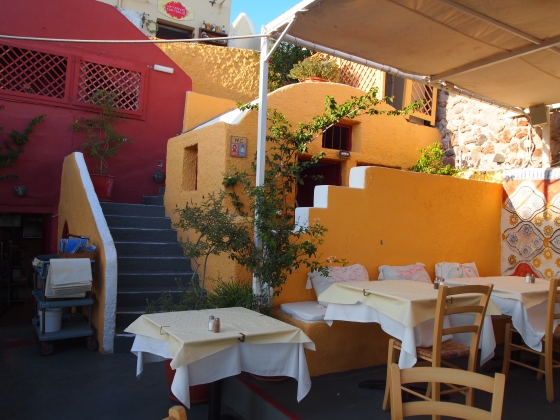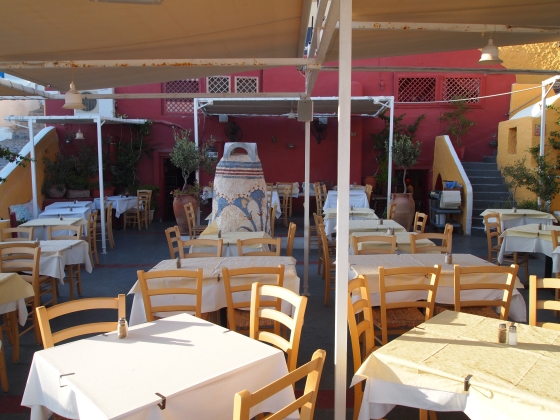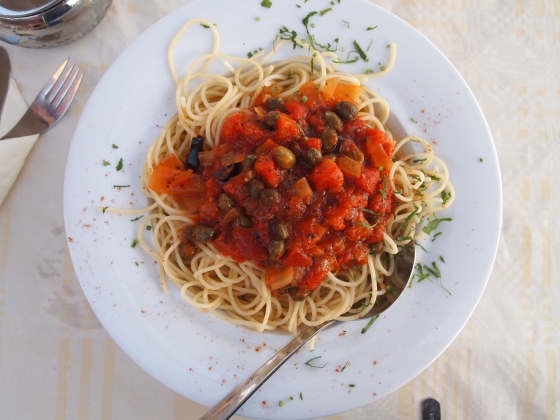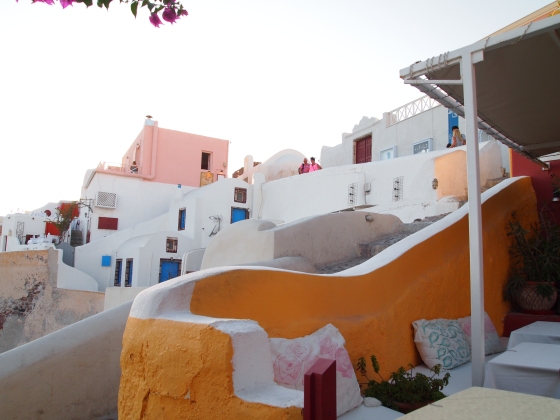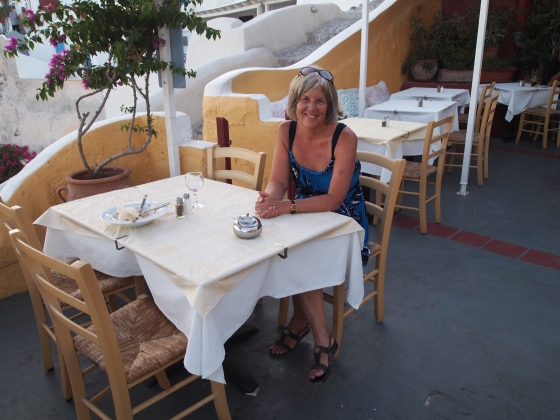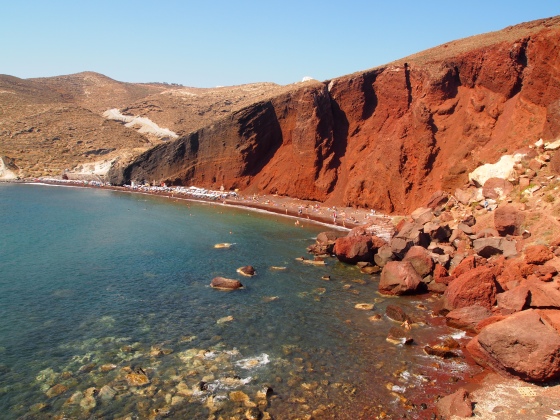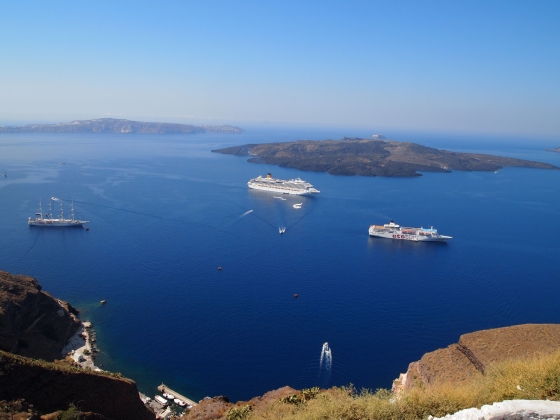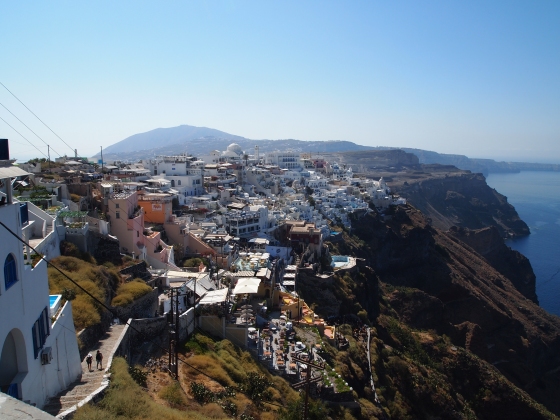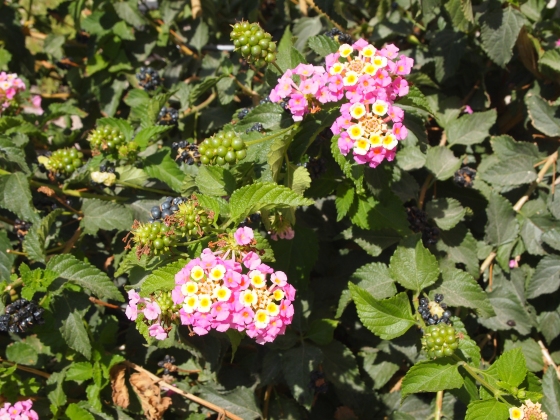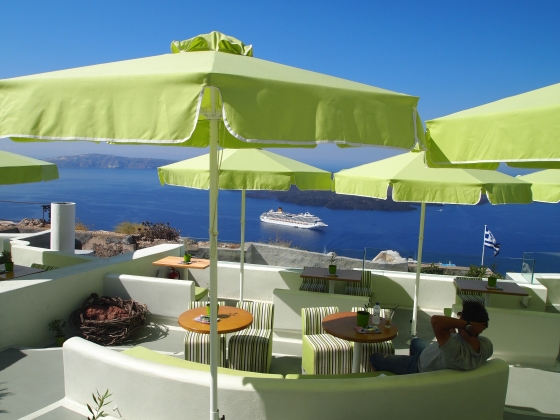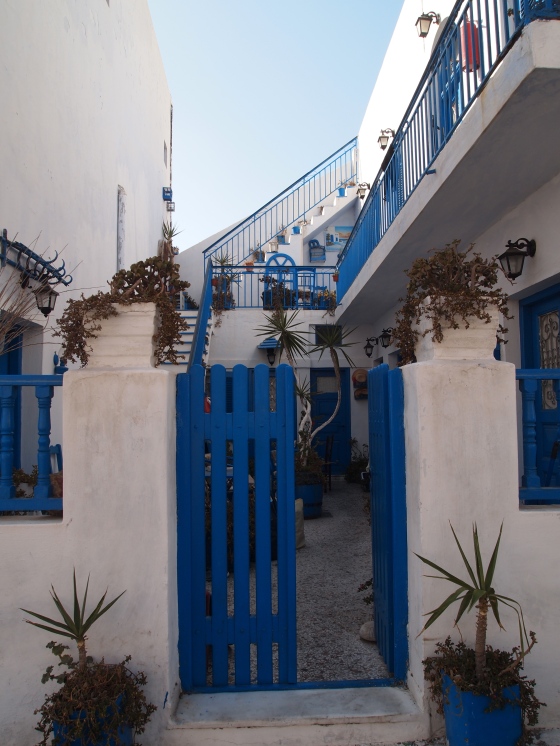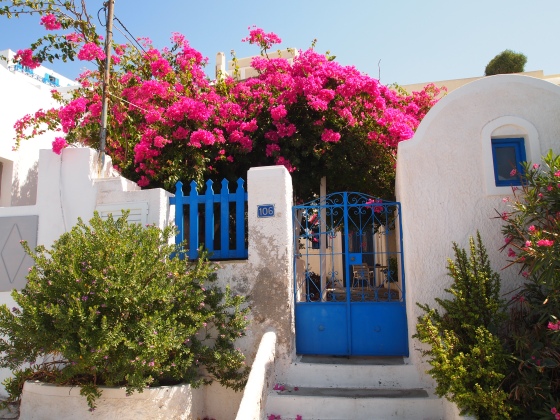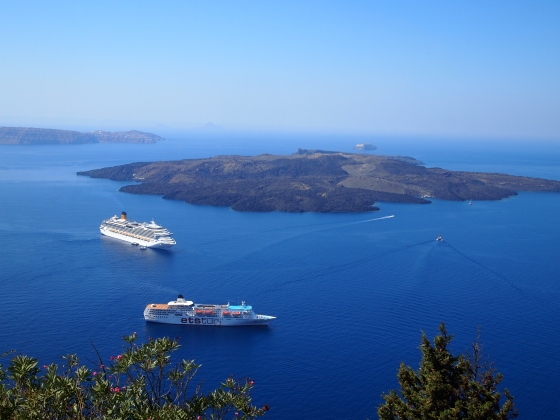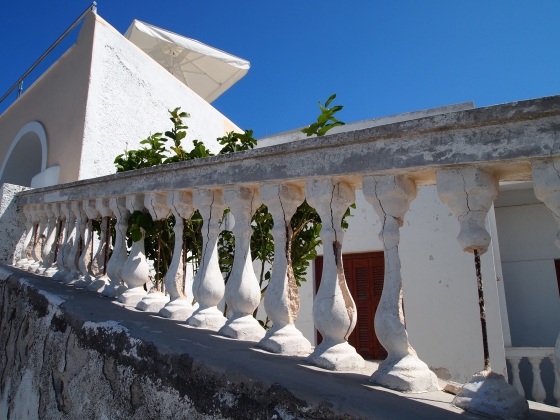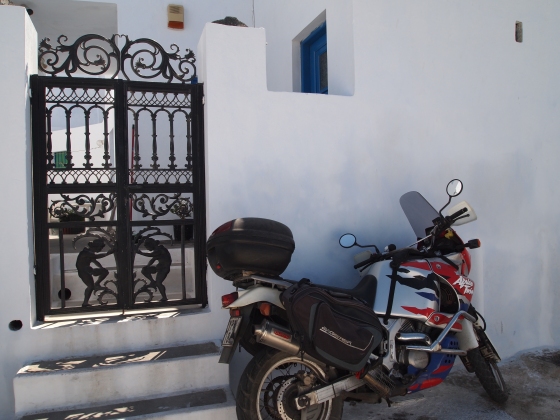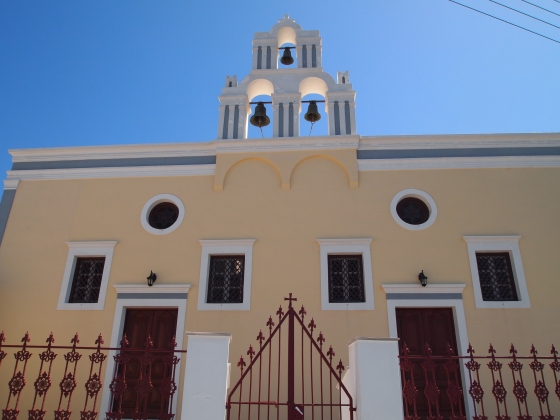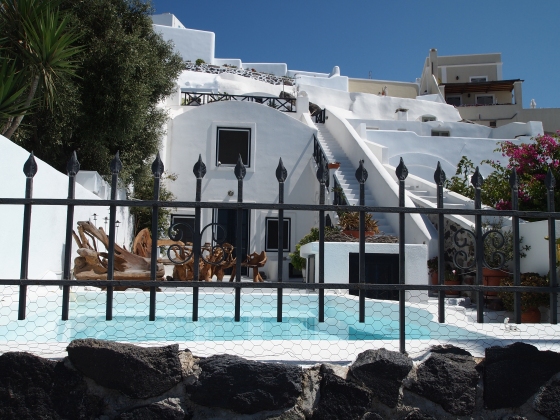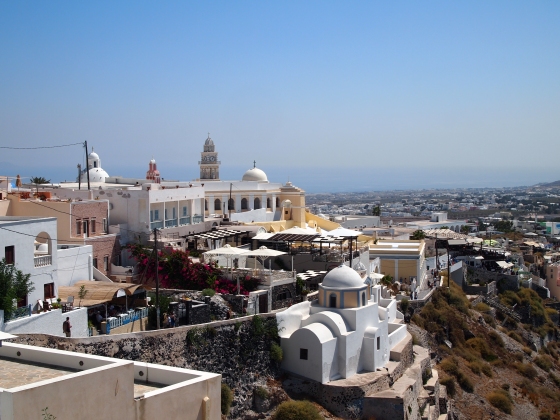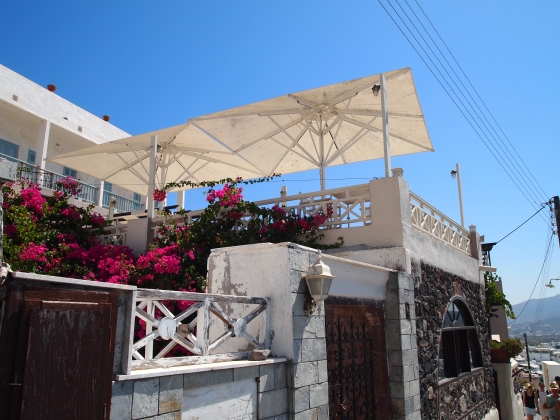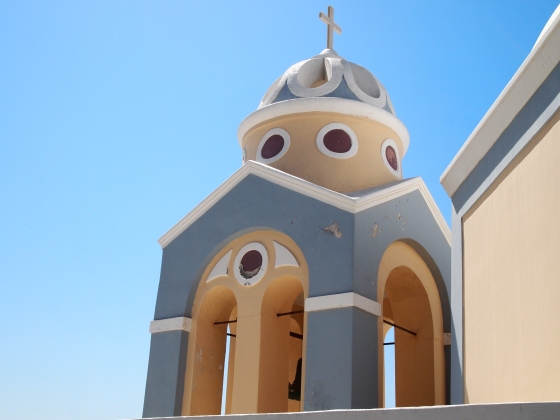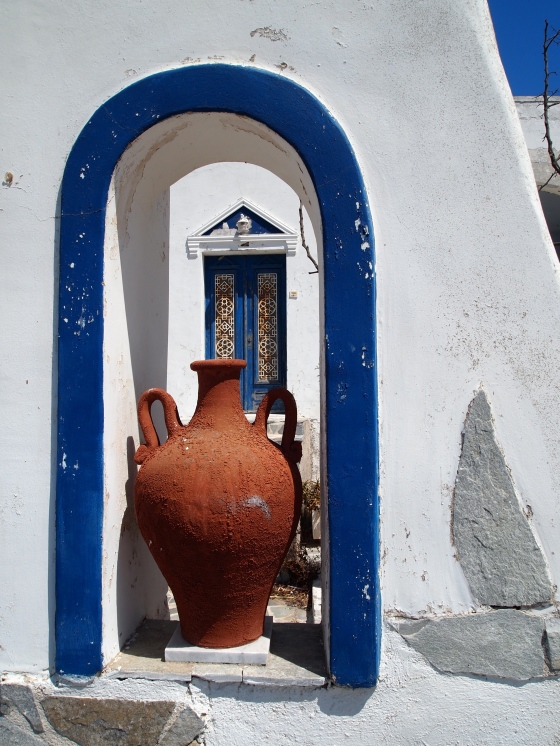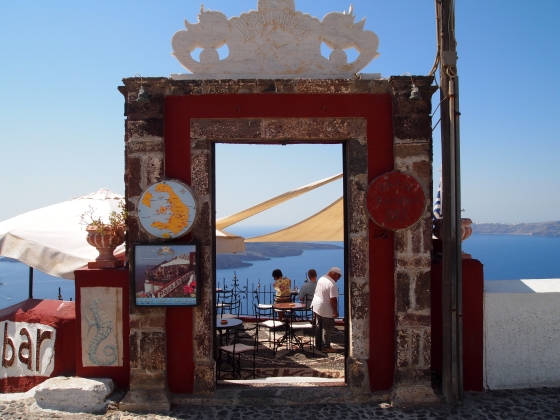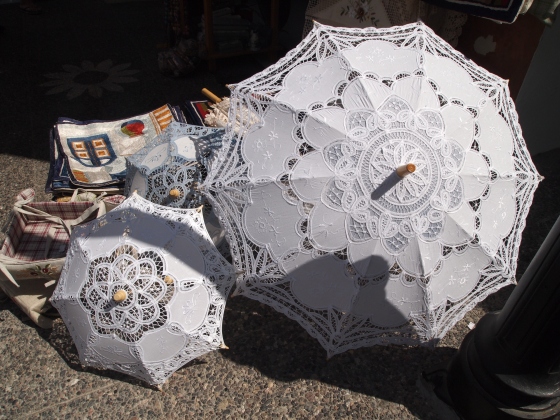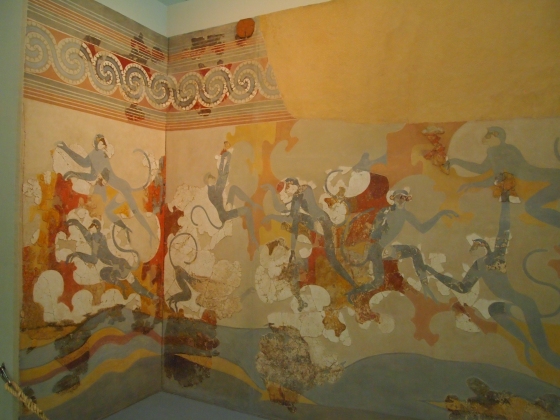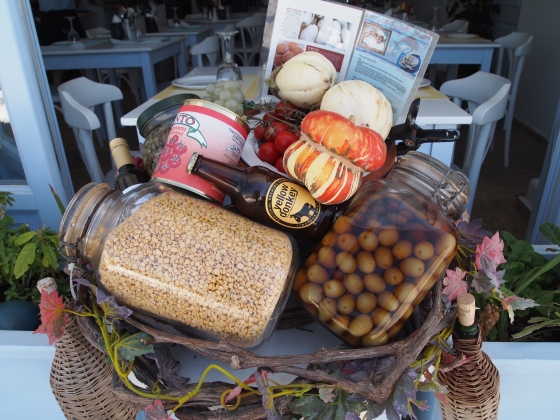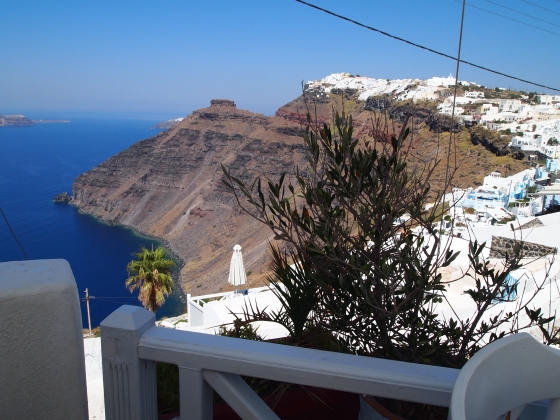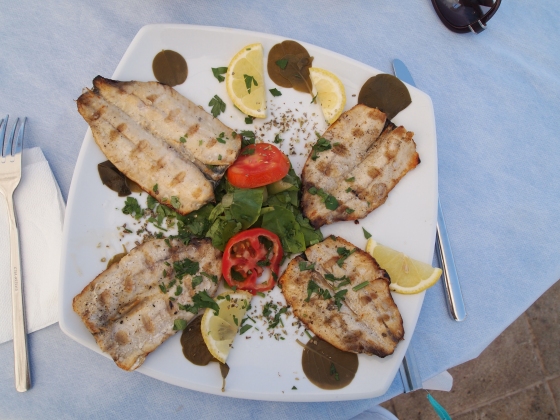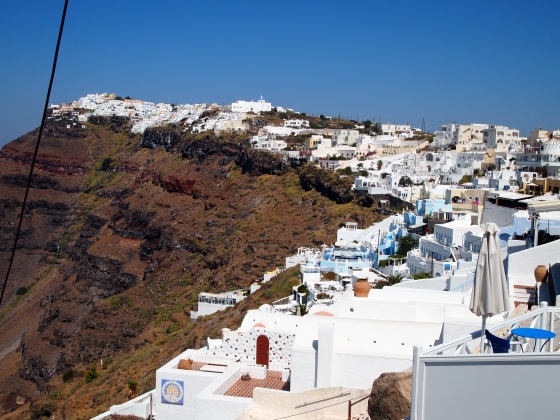Tuesday, September 11: Today, we visit the Meteora monasteries. The tour is sadly very limited, and today is the day I most regret being on a tour. If I had driven on my own, I would have visited more of the monasteries and stopped for many more photos. However, being stuck on a bus and limited by a timetable, I feel like I only see a small sliver of what there is to see in Meteora.
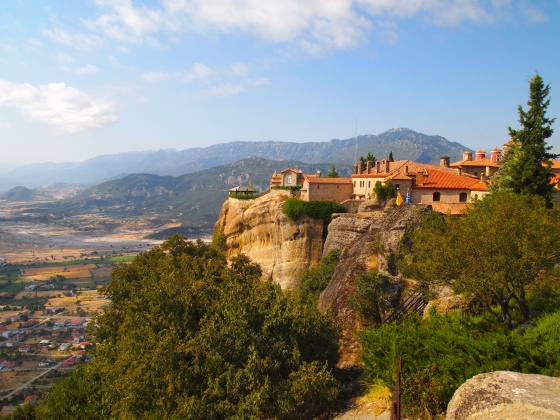
Moni Agiou Stefanou, or the Holy Monastery of St. Stephen
Though the tour is two days long, we spent all day yesterday driving to Delphi, visiting the archeological site briefly, then driving to Meteora. This morning, we get an early start after a decent buffet breakfast, but we head straightaway to an icon factory, where we are given a demonstration on how icons are made, and then we’re left to browse in the large icon and souvenir shop. Though I admittedly do buy something, a copy of a Byzantine icon which is supposed to bring luck on “new beginnings,” as well as a small bell much like one found in a monastery, I still consider this 45-minute stop a waste of time. Considering that we only get a couple of hours at the monasteries, and then have to drive 5 hours back to Athens, I feel sorely disappointed that I miss much of what there is to see in Meteora.

the gardens at the Monastery of St. Stephen
According to Lonely Planet Greece, as well as Wikipedia, the name Meteora derives from the Greek adjective meteoros, which means “suspended in the air.” The jutting pinnacles and cliffs of the Meteora were once sediments of an inland sea. The rocks, composed of a mixture of sandstone and conglomerate (limestone, marble, serpentine and metamorphic, interspersed with layers of sand and shale), were formed about 60 million years ago. A series of earth movements pushed the seabed upwards, creating a high plateau and causing many fault lines to appear in the thick layer of sandstone. Continuous weathering by water, wind and temperature extremes turned them into huge rock pillars, marked by horizontal lines which geologists maintain were made by the waters of a prehistoric sea.

we can light candles and say prayers at Monastery of St. Stephen

This is NOT actually a monk from the monastery but one of a group of visiting priests from Serbia. I’m sure he was thrilled that I asked him to pose!!
By the 11th century AD, natural caves that had been carved out of these pillars had become the homes for hermit monks. By the 14th century, the Byzantine power of the Roman Empire was fizzling out, and the Turks were invading Greece. Monks began to seek safe haven from the bloodshed and built monasteries atop the pillars. In the early monasteries, removable ladders were used to access the monasteries. Later, windlasses were used so monks could be hauled up in nets.
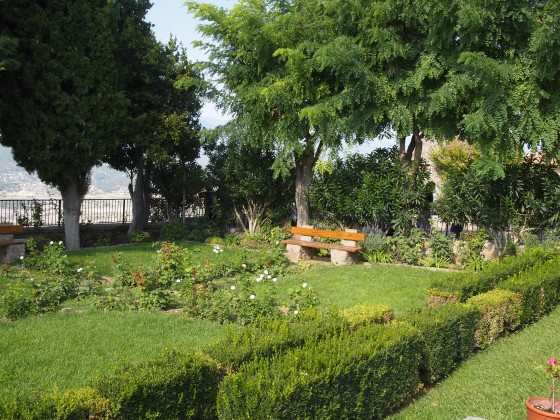
more gardens at the Monastery of St. Stephen
Eventually, 24 monasteries were built on these pinnacles. Today, six are active religious sites, occupied by monks or nuns. Today they are accessible by staircases cut into the rock formations. They were created to serve monks and nuns following the teachings of the Greek Orthodox Church.
The first monastery we visit is Moni Agious Stephanou, or the Monastery of St. Stephen, founded around 1400. It is now a nunnery. Although less spectacular than the others, it is the easiest monastery to visit and the nuns are welcoming.
According to Sacred Destinations: Agios Stefanos Monastery, Meteora, Moni Agious Stefanou was founded by St. Antoninus Cantacuzene, who is thought to be a son of the Serb ruler Nicephorus II of Epirus, around 1400.
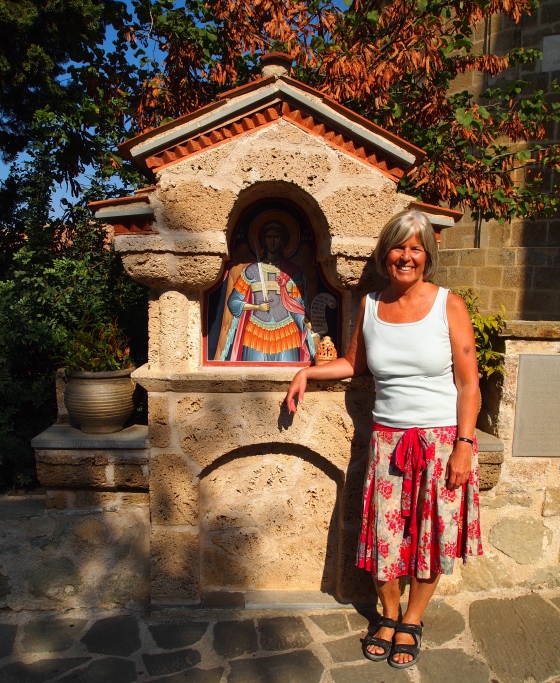
me next to the Icon of the Archangel Michael at the Monastery of St. Stephen
The monastery suffered much damage in the 20th century: it was bombed during World War II by the Nazis, who believed it was harboring insurgents. Then it was desecrated during the subsequent Civil War. In the latter period, most of the frescoes were defaced by Communist rebels.
St. Stephen’s was virtually abandoned until 1961, when it became a nunnery. It is currently inhabited by 28 nuns led by Abbess Agathi Antoniou.
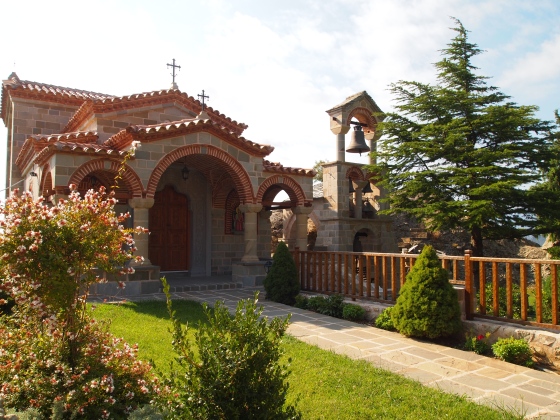
on the grounds of Monastery of St. Stephen
The grounds of the monastery are beautifully manicured and the views to the town of Kalambaka below are spectacular.

more gardens at Monastery of St. Stephen

the view from Monastery of St. Stephen to Kalambaka down below
There are different types of artistically designed bells; one is rung for breakfast, one for lunch and one for dinner.
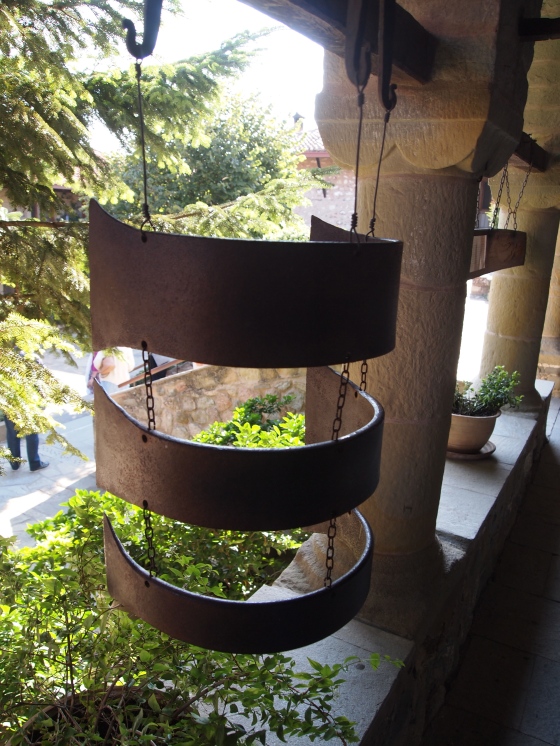
one of the bells rung for meals at the Monastery of St. Stephen

another cool bell at Monastery of St. Stephen
After leaving the Monastery of St. Stephen, we drive past the famous Moni Agias Triados, or Holy Trinity Monastery, where scenes in the 1981 James Bond film, For Your Eyes Only,were filmed. This monastery is one of the more difficult to access, but it doesn’t matter because it’s not on our tour! We stop along the road and are released briefly from our bus captivity to get out and take photos.
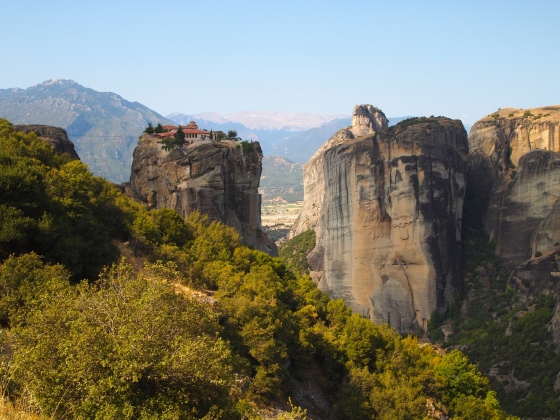
Moni Agias Triados, or Holy Trinity Monastery, where For Your Eyes Only was filmed
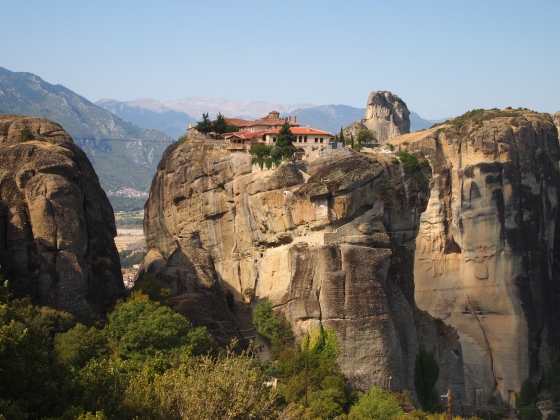
another view of Moni Agias Triados
Because I run quite a distance down the road from the bus to get as many pictures as I can, I arrive back to the bus late, only to be berated in a screeching voice by our carrot-headed guide: “You’re late! Why did you run all the way down the road? I told you only 5 minutes!” I yell back: “We don’t have enough time! You’re rushing us way too much!! This is ridiculous! You stop us for 45 minutes at an icon factory and yet you won’t give us an extra 5 minutes to take pictures!!” She yells back, “We have a 7 hour drive back to Athens this afternoon. We have a timetable!” Here she is exaggerating wildly, as the drive back to Athens from Meteora is actually only 5 hours. We are both fuming by this time and I am really irritated with this bitchy woman as well as myself for deciding to come on this blasted tour!! LIVE & LEARN!!
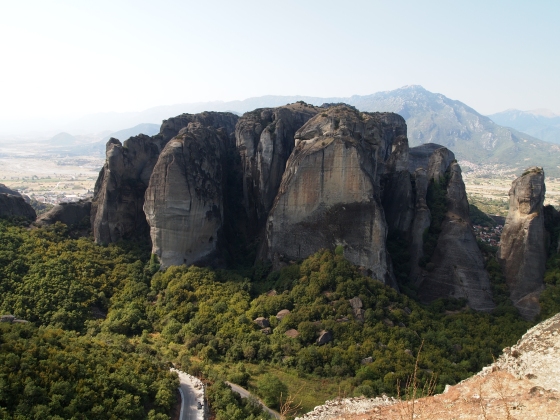
more of the Meteora pinnacles
Finally, we both settle down, although I’m seething inside. For me, travel is about a lot of things: experiencing a culture, enjoying the food and wine, lingering and soaking up the atmosphere, meeting interesting people, pushing myself outside my comfort zone, learning about myself, journaling about my adventures, and TAKING PICTURES. I love to take my time searching out interesting angles and light and subject matter. Not that I’m always successful, but I like to try. And a tour simply isn’t conducive to that.

a view of the other town at the foot of Meteora, Kastraki, with Alsos Rock on the left and Holy Spirit Rock on the right, and Moni Agias Varvaras Rousanou in the right foreground
We continue down the road only a slight distance to the 2nd of the two monasteries we will see, Moni Agias Varvaras Rousanou, or the Monastery of St. Barbara. We walk from a high cliff where we have a view of some of the pinnacles, down a path and then up a small wooden bridge to St. Barbara. The steep structure of this monastery is a stunning accomplishment. Today this is home to an order of 15 nuns.
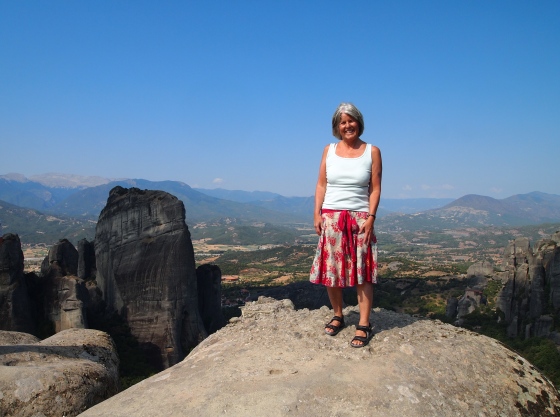
me at the top of one of the Meteora pillars
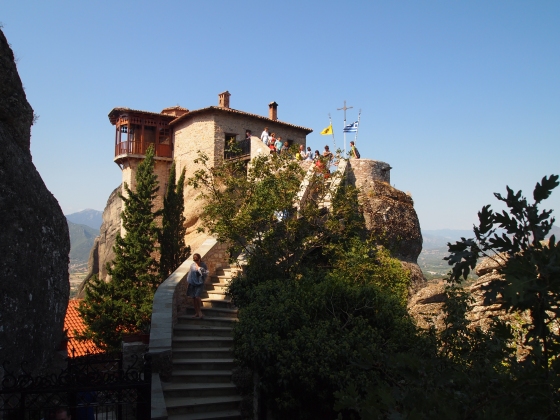
the entrance to Moni Agias Varvaras Rousanou, or the Monastery of St. Barbara
As we walk up the bridge to St. Barbara, we can see a beautiful garden down below.
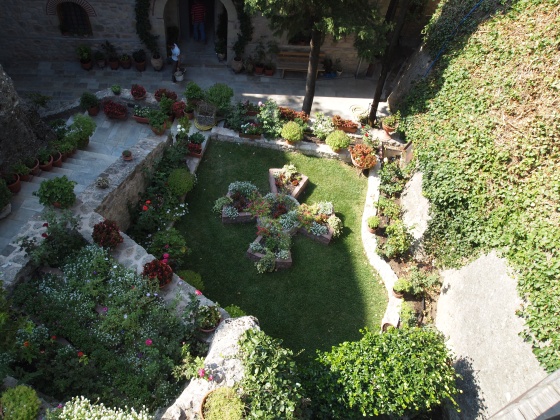
the garden at the Monastery of St. Barbara
Inside the very small monastery, which is packed with tourists, the nuns sell hand painted rocks with the monastery on the front. They sell the rocks or they’ll make them into a necklace. I can’t help but buy one because I like quirky jewelry and it helps to support the monastery.
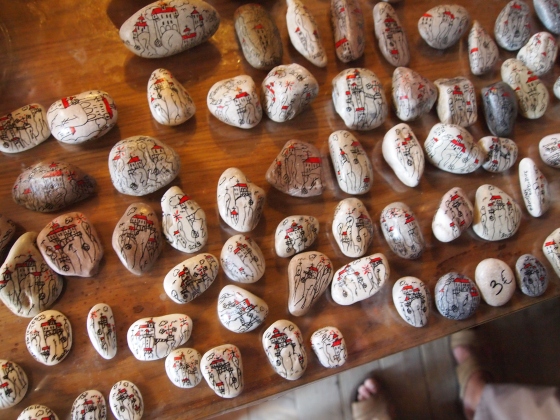
The stones painted with the monastery by the nuns. They will write your name on the back and make them into necklaces.
We get a tour of the beautiful stained-glass-illuminated katholikon; it’s gorgeous but tiny and of course we’re not allowed to take pictures.
From the deck of Monastery of St. Barbara, we can see Grand Meteora Monastery, which is built on the highest rock in the valley at 613 meters above sea level. St. Athanasios founded it in the 14th century and it became the richest and most powerful monastery because of a Serbian emperor Symeon Uros, who turned all his wealth over to the monastery and became a monk. Maybe this is why we see so many Serbian priests visiting the Monastery of St. Barbara today.

a view of Moni Megalou Meteorou, or Grand Meteora Monastery
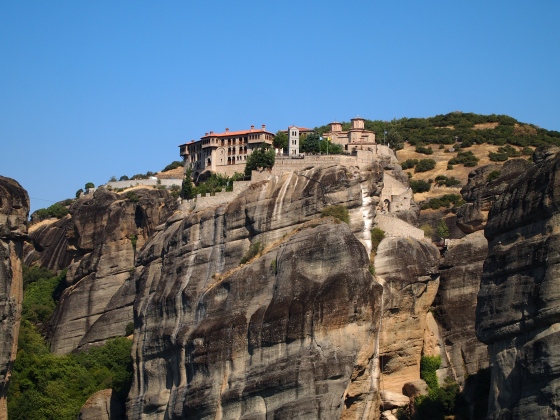
another view of Grand Meteora Monastery
I love the Meteora monasteries, but sadly the ones we see are overrun by tourists. Also, we only go inside of 2 of the 6 operating monasteries. I really wish I had gone alone and hiked on the trails between the monasteries. It is a beautiful day and I think I would have loved it. I’m going to have to go back there one day.
After we finish at Monastery of St. Barbara, we head into the town of Kalambaka, where we have lunch at the Meteora Restaurant. This restaurant has been run by the same family since 1925. We go into the kitchen where the owner and her daughters and sons are cooking a variety of different dishes in a cloud of steam. We are allocated bread, a meat dish of our choosing, and two vegetables for about 10 euros.
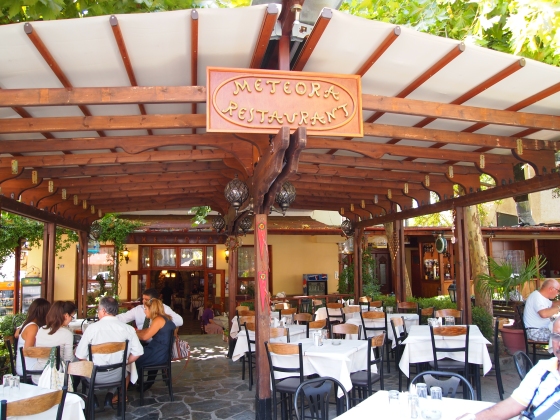
we have lunch at the Meteora Restaurant
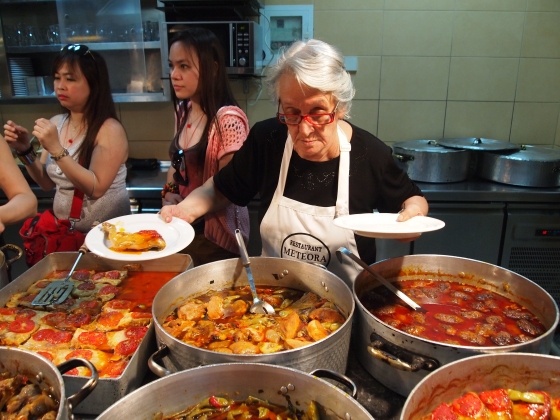
the proprietor at the Meteora Restaurant cooks up a feast
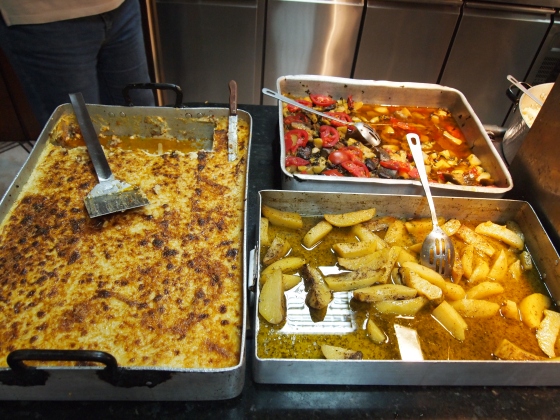
the kitchen at Meteora Restaurant
The lamb meatballs I have here are delectable! They’re one of those things in life that taste so good you don’t ever want to stop eating them, even when you’re stuffed. This is one of my favorite meals in Greece, after the cabbage rolls which I will eat the next two nights in Athens, and the eggplant rolls in Santorini.

homemade lamb meatballs & green peppers
We leave the restaurant at around 1:30 p.m. and head back to Athens, driving over much of the same course we traveled to get here, except veering off at Lamia to take a scenic route along the Gulf of Evia. Our guide tells us that Mama Mia! was filmed along this route. According to Wikipedia, most of the outdoor scenes were filmed on location at the small Greek island of Skopelos, and the seaside hamlet of Damouchari in the Pelion area of Greece. On Skopelos, Kastani beach on the south west coast was the film’s main location site. The producers built a beach bar and jetty along the beach, but removed both set pieces after production wrapped.
Either way, from our bus, we are unable to see this location, so I don’t even know why our lunatic guide tells us this.
We arrive back in Athens around 6:30, exactly 5 hours after leaving Kalambaka. Surprise, surprise! It wasn’t anywhere near seven hours, as the guide claimed during our yelling match!












































